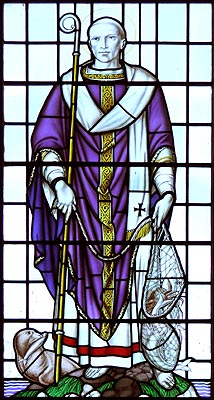St. Wilfrid's Church
| St. Wilfrid's Church LB, dark. AndyMatthews (talk) 18:17, 9 January 2025 (UTC)
|
| St. Wilfrid's Church
Santlerville [79,28]
Basic Info:
|
St. Wilfrid's Church [79, 28] is one of three places of worship in the suburb of Santlerville and is located in the South and on the Eastern edge, it borders on the suburb of Gibsonton.
Description
St. Wilfrid's Church is a church with a difference. Whereas virtually all other churches throughout the Suburbs of Malton have been abandoned and left to rot and turn into the domain of the undead, St. Wilfrid's still remains a warm, inviting and above all safe place for survivors in SE Santlerville in need of comfort and prayer. Please come to visit St. Wilfrid's Church and share in the community spirit that makes Santlerville such a special place to be.
Barricading Policy
The Santlerville Barricade Policy designed by the Dribbling Beavers of Santlerville provides that this building should be barricaded to EHB. The Uniform Barricade Plan makes no specific provision for barricading of churches in general as they are not important Tactical Resource Points.
The nearest designated Entry Point to St. Wilfrid's Church is The Anthony Building just 2W, 1N and is also the Entry Point to Dowdney Mall.
Note: Although churches are usually low on the priority for being powered, maintained and even barricaded, St. Wilfrid's Church is an exception. It is part of the "Citadel" for the Sons of Abraham, who kindly look after this church in an attempt to keep at least some sense of community and comfort for those living in the harsh times of post apocalyptic, zombie infested Malton.
| UBP-Compliant Barricade Plan | |
| This location is designated to be barricaded at EHB(+4) under the Santlerville Barricade Plan. |
The Local Area
Area Map
St. Wilfrid's Church is on the east edge of Santlerville and so it borders on the suburb of Gibsonton. The area map for the two suburbs can be seen here.
Tactical Resource Points
The nearest of each type of tactical resource point to St. Wilfrid's Church:
- Nearest Hospital is just 1 block West - St. Boniface's Hospital at [78,28]
- Nearest Mall is just 3 blocks West - the NE corner of Dowdney Mall at [76,28]
- Nearest NecroTech Building is 4W, 3N blocks away - The Hall Building at [75,25]
- Nearest Auto Repair Shop is just 1SW - Popham Auto Repair at [78,29]
- Nearest Cathedral is just 2E, 1N block away - the SW corner of St. Matthew's Cathedral at [81,27]
Other services such as a Factory or Police Department are rather distant. However, the proximity of Dowdney Mall means that all the supplies a survivor needs is never far away.
Church Status
St. Wilfrid's Church is part of the "Citadel" for the Sons of Abraham and so is barricaded, maintained and frequently patrolled by members of their group. It is not unusual to find the Church powered, lit and with a good sized congregation inside. Though Churches make easy targets because they have no doors that can be secured should all the barricades fail, St. Wilfrid's is actively protected enough to make most ferals Graagh twice before attempting to violate this place of worship.
Recently a member of the Cult of the Unseen Ones discovered this Church empty and a radio transmitter was found inside. The cult has recently been using it for worship as well as radio transmissions to advertise. All believers in the Unseen are welcome to visit. Seeing as it is near the Temple of the Unseen it may be useful to pray before beginning the Pilgrimage of the Unseen. We have dedicated ourselves to mantaining this site of worship and do not consider this site to be solely dedicated to worshipping the Unseen. We are willing to share.
About Saint Wilfrid
St. Wilfrid (634-709 CE), often referred to as St. Wilfrid of York, was one of Britain's greatest early religious figures.
Wilfrid was the son of a thain of Northumbria. He was sent to the court of King Oswy in his teens because he did not get along with his stepmother, but there he attracted the attentions of Queen Eanfleda and asked to be sent to the monastery at Lindisfarne. After three years, he studied in Rome under the Pope's archdeacon Boniface. He thereafter became a protege of Annemundas, the bishop of Lyons, who wanted Wilfrid to marry his niece and become his heir. Wilfrid declined because of his determined desire to enter the priesthood. Soon after, Annemundas was murdered in a savage persecution; Wilfrid escaped with his life only because he was a Saxon and pledged to return to England.
On his return, Wilfrid became the abbot of the newly-founded monastery at Ripon; while there, he instituted Roman rules and clerical practices. His support of Roman supremacy over the northern and Scottish monks during the Synod of Whitby in 664 purchased for him the bishopric of Northumbria. But Wilfrid refused to be consecrated by the northern bishops he had opposed in the Synod, traveling instead to Compiègne. He was delayed in France for some time, then shipwrecked on his return in 666 and nearly killed by Sussex heathens when he washed ashore. By the time Wilfrid finally returned to Northumbria, he had been replaced as bishop by St. Chad, so he returned to his monastery at Ripon. In 669, however, Archbishop Theodore of Canterbury visited Northumbria and was dissatisfied with Chad's bishopric; he forced Chad to withdraw and installed Wilfrid as bishop once again. As bishop, Wilfrid zealously defended Roman authority over the Scottish bishops and founded many Benedictine monasteries.
Upon the death of King Oswy, however, Wilfrid's state of affairs began to decline. Oswy's successor, Ecgfrid, disliked Wilfrid because the latter had urged Ecgfrid's bride Etheldrida to enter a convent rather than live with her husband. Soon after, Archbishop Theodore acted to subdivide Wilfrid's bishopric into three smaller areas, planning to install cronies in each new position to dilute Wilfrid's authority. Wilfrid, doubting Theodore's power to do so, left for Rome to appeal his case. Either Theodore or Ecgfrid contracted to have Wilfrid detained en route, but the men they hired captured Winfrid, Bishop of Lichfield, who by coincidence had a nearly identical name and title and was traveling to Rome at the same time. The council appointed by the Pope to settle the question ruled in Wilfrid's favor, and the new bishops were removed, but Ecgfrid first imprisoned and then exiled Wilfrid anyway.
Wilfrid ministered in exile for some five years, but in 686 he returned to Northumbria; the new king Aldfrid had since succeeded to Ecgfrid's throne, and Wilfrid was able to make peace with Theodore. Eventually, though, because Theodore was convinced that he had subdivided Wilfrid's bishopric and Wilfrid was equally convinced that Rome had annulled the division, Wilfrid was forced to bring his case to Rome yet again. After long proceedings in Rome, Wilfrid prevailed again, and in 706 the Synod of the River Nidd was convened to render a final judgment. The synod, however, granted Wilfrid the bishoprics of Hexham and Ripon but denied him the bishopric of York, the historic seat of his constituency. While the decision was unsatisfactory, Wilfrid accepted it because it represented the exercise of Roman authority, for which he had fought for 45 years.

